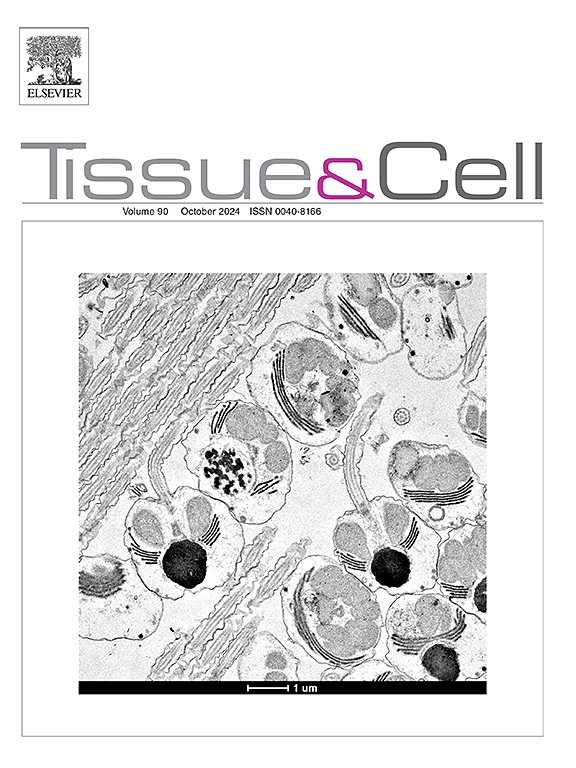熊果苷通过抑制心肌成纤维细胞活化改善心肌梗死后心功能障碍
IF 2.7
4区 生物学
Q1 ANATOMY & MORPHOLOGY
引用次数: 0
摘要
darbutin具有多种作用,包括抗炎、抗氧化和清除自由基,但其在心血管系统中的研究仍然有限。目的探讨熊果苷对左前降支结扎致小鼠心肌梗死的影响。方法通过网络药理学研究预测熊果苷对心肌梗死的作用机制。为评价熊果苷对心肌梗死时心功能的影响,在不同时间点对小鼠进行心脏TTC染色,并进行超声心动图。进一步采用Western blot检测α - sma、I型胶原、III型胶原,探讨熊果苷对心肌纤维化的影响,并检测其对ERK1/2磷酸化水平的影响,从而阐明其潜在的作用机制。结果网络药理学数据提示熊果苷可能通过调节ERK1/2信号通路对心肌梗死起有益作用。体内实验结果表明,熊果苷能减轻心肌梗死后心肌纤维化和心肌肥厚,显著改善心功能。进一步的体外实验证实,熊果苷显著降低纤维化相关指标,这一过程部分是通过调控ERK1/2磷酸化实现的。综上所述,本研究表明熊果苷通过作用于ERK1/2信号通路发挥显著的保护作用,可有效抑制心肌纤维化,从而减轻LAD结扎引起的心肌梗死。本文章由计算机程序翻译,如有差异,请以英文原文为准。
Arbutin improves post-myocardial infarction cardiac dysfunction by inhibiting cardiac fibroblast activation
Background
Arbutin exhibits multiple effects, including anti-inflammatory, antioxidant, and scavenging of free radicals, yet its research within the cardiovascular system remains limited.
Purpose
This study aims to investigate the effects of arbutin on myocardial infarction induced by left anterior descending (LAD) ligation in mice.
Methods
The possible mechanism of arbutin's effect on myocardial infarction was predicted through network pharmacology studies. To evaluate the impact of arbutin on cardiac function in myocardial infarction, TTC staining of the heart was performed, and echocardiography was conducted on mice at different time points. Furthermore, Western blot analysis was utilized not only to detect αSMA, Collagen I, and Collagen III, aiming to investigate the impact of arbutin on myocardial fibrosis but also to detect the influence of arbutin on the phosphorylation level of ERK1/2, thereby elucidating its potential mechanism of action.
Results
Network pharmacology data suggest that arbutin may exert a beneficial effect on myocardial infarction by modulating the ERK1/2 signaling pathway. In vivo experimental results indicate that after myocardial infarction, arbutin can alleviate myocardial fibrosis and cardiac hypertrophy, significantly improving cardiac function. Further in vitro experiments confirm that arbutin markedly reduces fibrosis-related indicators, and this process is partially achieved through the regulation of ERK1/2 phosphorylation.
Conclusion
In conclusion, this study reveals that arbutin exerts a significant protective effect by acting on the ERK1/2 signaling pathway, effectively inhibiting myocardial fibrosis, and subsequently attenuating myocardial infarction induced by LAD ligation.
求助全文
通过发布文献求助,成功后即可免费获取论文全文。
去求助
来源期刊

Tissue & cell
医学-解剖学与形态学
CiteScore
3.90
自引率
0.00%
发文量
234
期刊介绍:
Tissue and Cell is devoted to original research on the organization of cells, subcellular and extracellular components at all levels, including the grouping and interrelations of cells in tissues and organs. The journal encourages submission of ultrastructural studies that provide novel insights into structure, function and physiology of cells and tissues, in health and disease. Bioengineering and stem cells studies focused on the description of morphological and/or histological data are also welcomed.
Studies investigating the effect of compounds and/or substances on structure of cells and tissues are generally outside the scope of this journal. For consideration, studies should contain a clear rationale on the use of (a) given substance(s), have a compelling morphological and structural focus and present novel incremental findings from previous literature.
 求助内容:
求助内容: 应助结果提醒方式:
应助结果提醒方式:


